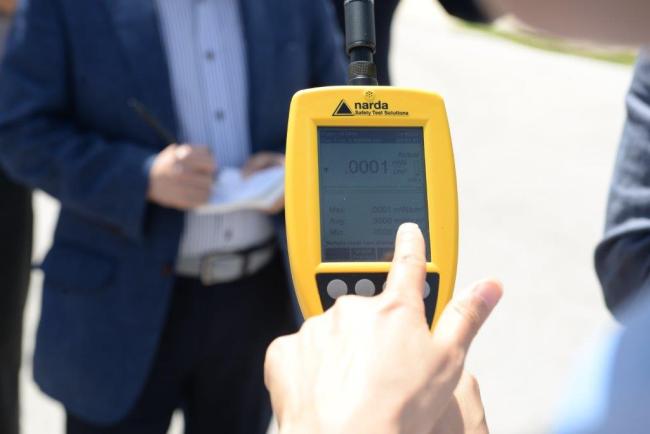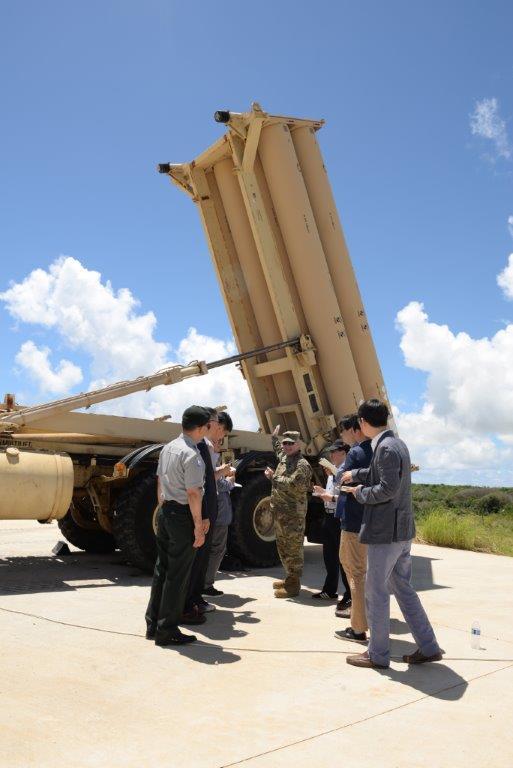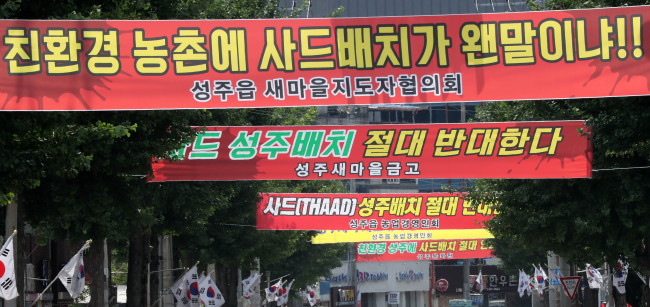THAAD electromagnetic radiation in Guam near background level
By Shin Hyon-heePublished : July 18, 2016 - 16:41
GUAM -- The U.S. showed its Terminal High Altitude Area Defense battery stationed in Guam for the first time to the outside world on Tuesday as South Korea struggles to defuse concerns over the possible health and environmental impact of the system’s planned deployment here.
Members of the local press kicked off a three-day tour to the Anderson Air Force Base alongside officials from Seoul’s Defense Ministry with the support of the U.S. military. They were scheduled to look around the battery, its associated AN/TPY-2 X-band radar and other facilities, examining the amount of electromagnetic radiation, the noise level of emergency generators and other possible impacts on the surrounding environment.
The unprecedented trip came as rumors have been snowballing that the equipment may cause cancer, infertility and crop damage, since the allies unveiled their decision to deploy it on July 8 and picked Seongju, North Gyeongsang Province, as the location last Wednesday. The county residents expressed staunch opposition, calling for the plan to be shelved.
Members of the local press kicked off a three-day tour to the Anderson Air Force Base alongside officials from Seoul’s Defense Ministry with the support of the U.S. military. They were scheduled to look around the battery, its associated AN/TPY-2 X-band radar and other facilities, examining the amount of electromagnetic radiation, the noise level of emergency generators and other possible impacts on the surrounding environment.
The unprecedented trip came as rumors have been snowballing that the equipment may cause cancer, infertility and crop damage, since the allies unveiled their decision to deploy it on July 8 and picked Seongju, North Gyeongsang Province, as the location last Wednesday. The county residents expressed staunch opposition, calling for the plan to be shelved.

During a demonstration, electromagnetic radiation measured 1.6 kilometers away from the radar peaked at 0.0007 and averaged at 0.0003 watts per square meter over a period of six minutes. The distance is similar to that between the proposed location and closest village in Seongju.
The figures are far lower than the 10-watt-per-square-meter limit preserved in local and international guidelines, which indicate that exposure to greater levels could result in body-heat stress and excessive partial tissue heating, officials said.
Due to noise from the generator, most conversations could not be heard when approaching the radar. But the noise faded away once arriving at a launch pad some 500 meters away.
“In terms of (electromagnetic) waves, the peak value is a level that can occur in everyday life,” a Seoul military official said.
Introduced in April 2013, the Site Armadillo in Guam is deemed vital to counter North Korea’s missile threats highlighted by its recent successful test of the Musudan intermediate-range ballistic missile, which puts the Pacific island within reach.
The lieutenant colonel-led mission manages of about 200 troops, six truck mounted launchers, a radar and related support installations.
The figures are far lower than the 10-watt-per-square-meter limit preserved in local and international guidelines, which indicate that exposure to greater levels could result in body-heat stress and excessive partial tissue heating, officials said.
Due to noise from the generator, most conversations could not be heard when approaching the radar. But the noise faded away once arriving at a launch pad some 500 meters away.
“In terms of (electromagnetic) waves, the peak value is a level that can occur in everyday life,” a Seoul military official said.
Introduced in April 2013, the Site Armadillo in Guam is deemed vital to counter North Korea’s missile threats highlighted by its recent successful test of the Musudan intermediate-range ballistic missile, which puts the Pacific island within reach.
The lieutenant colonel-led mission manages of about 200 troops, six truck mounted launchers, a radar and related support installations.

Despite “operational security concerns,” the U.S. had decided to unlock the facility in the face of increasingly stiff public resistance.
But Marine Corps Maj. Gen. Robert Hedelund, the assistant chief of staff for strategy, plans, and policy at the U.S. Forces Korea who accompanied the delegation as a co-chair of a joint working group on the THAAD stationing, warned against “drawing too many conclusions” from the tour.
Every deployment solution is “different and unique” he said, pointing to the difference between Guam and the Korean Peninsula.
He also vowed to prevent any environmental and health effect around Seongju by applying safety rules of the Guam base, which he said are higher than U.S. government standards.
In Guam, for instance, the battery was put in place after clearing about 144,500 square meters of jungle in the north. In Seongju, the radar is expected to be positioned nearly 400 meters above sea level.
But Marine Corps Maj. Gen. Robert Hedelund, the assistant chief of staff for strategy, plans, and policy at the U.S. Forces Korea who accompanied the delegation as a co-chair of a joint working group on the THAAD stationing, warned against “drawing too many conclusions” from the tour.
Every deployment solution is “different and unique” he said, pointing to the difference between Guam and the Korean Peninsula.
He also vowed to prevent any environmental and health effect around Seongju by applying safety rules of the Guam base, which he said are higher than U.S. government standards.
In Guam, for instance, the battery was put in place after clearing about 144,500 square meters of jungle in the north. In Seongju, the radar is expected to be positioned nearly 400 meters above sea level.

Yet even though the Guam radar has proven it is harmless for now, the focal point would be how to manage to convince Seongju citizens and politicians who are against the plan.
In a fresh bid to quell the residents’ opposition, the military is seeking to arrange another tour for them to Guam.
Seongju County Gov. Kim Hang-gon has recently demanded a field inspection with a team of villagers and experts. During a meeting with senior journalists based in Daegu and North Gyeongsang regions later in the day, Defense Minister Han Min-koo said he will consult with the U.S. on the trip if the residents want, while pledging to continue dialogue with them to tackle their concerns.
By Shin Hyon-hee and Joint Press Corps (heeshin@heraldcorp.com)
In a fresh bid to quell the residents’ opposition, the military is seeking to arrange another tour for them to Guam.
Seongju County Gov. Kim Hang-gon has recently demanded a field inspection with a team of villagers and experts. During a meeting with senior journalists based in Daegu and North Gyeongsang regions later in the day, Defense Minister Han Min-koo said he will consult with the U.S. on the trip if the residents want, while pledging to continue dialogue with them to tackle their concerns.
By Shin Hyon-hee and Joint Press Corps (heeshin@heraldcorp.com)





![[Graphic News] Number of coffee franchises in S. Korea rises 13%](http://res.heraldm.com/phpwas/restmb_idxmake.php?idx=644&simg=/content/image/2024/05/02/20240502050817_0.gif&u=)



![[Robert J. Fouser] AI changes rationale for learning languages](http://res.heraldm.com/phpwas/restmb_idxmake.php?idx=644&simg=/content/image/2024/05/02/20240502050811_0.jpg&u=)







![[Eye Interview] 'If you live to 100, you might as well be happy,' says 88-year-old bestselling essayist](http://res.heraldm.com/phpwas/restmb_idxmake.php?idx=652&simg=/content/image/2024/05/03/20240503050674_0.jpg&u=)
